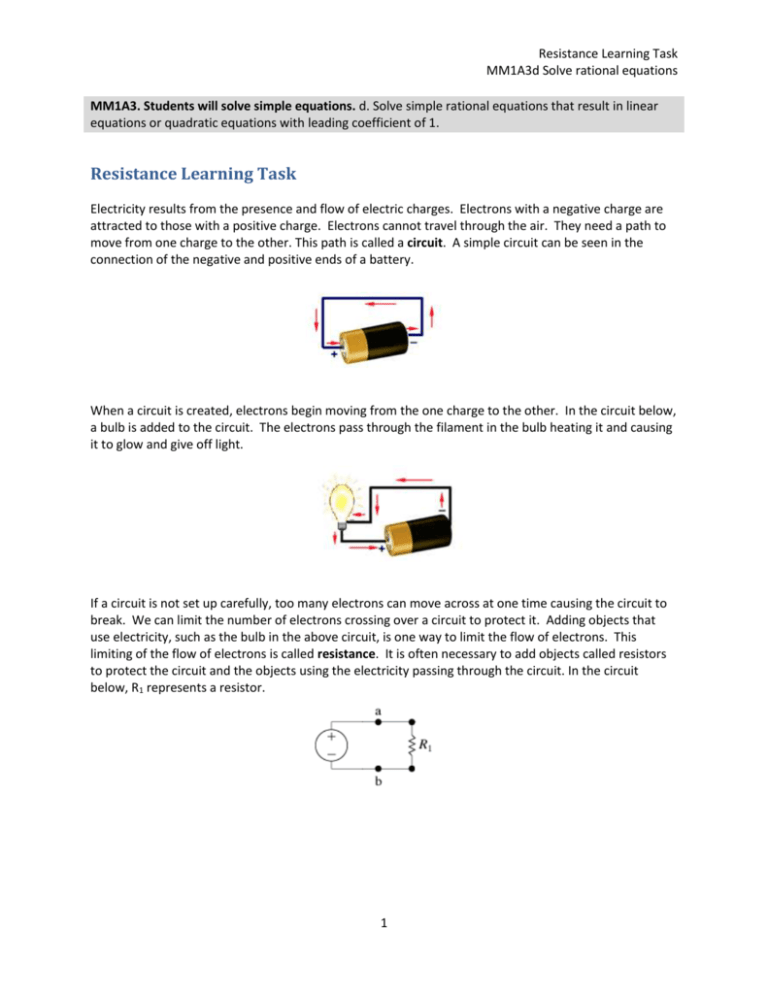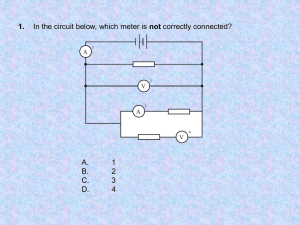Resistance Learning Task
advertisement

Resistance Learning Task MM1A3d Solve rational equations MM1A3. Students will solve simple equations. d. Solve simple rational equations that result in linear equations or quadratic equations with leading coefficient of 1. Resistance Learning Task Electricity results from the presence and flow of electric charges. Electrons with a negative charge are attracted to those with a positive charge. Electrons cannot travel through the air. They need a path to move from one charge to the other. This path is called a circuit. A simple circuit can be seen in the connection of the negative and positive ends of a battery. When a circuit is created, electrons begin moving from the one charge to the other. In the circuit below, a bulb is added to the circuit. The electrons pass through the filament in the bulb heating it and causing it to glow and give off light. If a circuit is not set up carefully, too many electrons can move across at one time causing the circuit to break. We can limit the number of electrons crossing over a circuit to protect it. Adding objects that use electricity, such as the bulb in the above circuit, is one way to limit the flow of electrons. This limiting of the flow of electrons is called resistance. It is often necessary to add objects called resistors to protect the circuit and the objects using the electricity passing through the circuit. In the circuit below, R1 represents a resistor. 1 Resistance Learning Task MM1A3d Solve rational equations More than one resistor can be placed on a circuit. The placement of the resistors determines the total effect on the circuit. The resistors in the diagram below are placed in parallel (this refers to the fact that there are no resistors directly between two resistors, not to the geometric definition of parallel). Parallel resistors allow multiple paths for the electricity to flow. Two examples of parallel resistors are shown below. The resistors in the next circuit below are not parallel. These resistors are placed in series because the electricity must travel through all three resistors as it travels through the circuit. Resistance is measured in units called ohms and must always be a positive number. The omega symbol, Ω, is used to represent ohms. For n resistors in parallel, R1, R2, R3, etc. the total resistance, RT, across a circuit can be found using the equation: 1 1 1 1 R T R1 R 2 R 3 1 Rn For n resistors in series, R1, R2, R3, etc. the total resistance, RT, across a circuit can be found using the equation: RT R1 R2 R3 2 Rn Resistance Learning Task MM1A3d Solve rational equations 1. What is the total resistance for a circuit with three resistors in series if the resistances are 2 ohms, 5 ohms, and 4 ohms, respectively? Draw a diagram of these resistors in series. 2. What is the total resistance for a circuit with two parallel resistors, one with a resistance of 3 ohms and the other with a resistance of 7 ohms? Draw a diagram of these resistors in parallel. 3. What is the total resistance for a circuit with four resistors in parallel if the resistances are 1 5 3 ohm, 3 ohms, 2 ohms, and 5 ohms, respectively? 4. What is the total resistance for the circuit to the right? 3 Resistance Learning Task MM1A3d Solve rational equations 28 5. A circuit with a total resistance of 11 has two parallel resistors. One of the resistors has a resistance of 4 ohms. What is the resistance of the other resistor? Show all your work in getting from a formula to a solution. Hints are available – see your teacher. 6. A circuit has been built using two parallel resistors. a. One resistor has twice the resistance of the other. If the total resistance of the circuit is 3 4 ohms, what is the resistance of each of the two resistors? b. One resistor has a resistance of 4 ohms. If the total resistance is one-third of that of the other parallel resistor, what is the total resistance? 4 Resistance Learning Task MM1A3d Solve rational equations 7. A circuit has been built using two paths for the flow of the current; one of the paths has a single resistor and the other has two resistors in series as shown in the diagram at the right. For the two resistors in series, the second has a resistance that is three times the resistance of the first one in the series. The single resistor has a resistance that is 6 ohms more than the resistance of the first resistor in series, and the total resistance of the circuit is 4 Ω. Write an equation to model this situation, and solve this equation. What is the resistance of the each of the resistors? 5 R R+6 3R Resistance Learning Task MM1A3d Solve rational equations Challenge: Build a Resistor Congratulations! You’re an electrical engineer. At your first day on the job, you’ve been asked to build a circuit with the following equivalent resistances. You will need to place resistors in parallel and series for these. You have the following individual resistors: 0.330 k 1.2 k 2.2 k 6.8 k 10 k 1000 k 1 k 1.5 k 4.7 k 8.2 k 22 k RT value #1: ________________________________ Diagram: Solve the equation: RT value #2: ________________________________ Diagram: Solve the equation: 6








